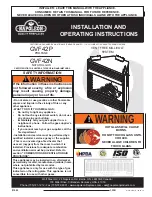
Model Number
(Length) - MBH
Mounting
Angle*
Sides
Front
Behind
Top
Below
25,000 & 30,000 BTU/h MODELS
LS3 (10, 15) - 25 [N, P]
0°
8
(20)
8
(20)
4
(10)
36
(91)
LS3 (10, 15) - 30 [N, P]
45°
39
(99)
8
(20)
10
(25)
36
(91)
with 1 side shield
0°
29
(74)
8
(20)
4
(10)
36
(91)
with 2 side shields
0°
9
(23)
9
(23)
4
(10)
36
(91)
40,000 BTU/h MODELS
LS3 (15, 20) - 40 [N, P]
0°
15
(38)
15
(38)
6
(15)
45
(114)
45°
58
(147)
8
(20)
10
(25)
45
(114)
with 1 side shield
0°
42
(107)
8
(20)
6
(15)
45
(114)
with 2 side shields
0°
20
(151)
20
(51)
6
(15)
45
(114)
50,000 BTU/h MODELS
LS3 (15, 20, 30) - 50 [N, P]
0°
11
(28)
11
(28)
6
(15)
48
(122)
45°
39
(99)
8
(20)
10
(25)
48
(122)
with 1 side shield
0°
29
(74)
8
(20)
6
(15)
48
(122)
with 2 side shields
0°
16
(41)
16
(41)
6
(15)
48
(122)
20 ft. from burner
0°
7
(18)
7
(18)
6
(15)
30
(76)
Chart 2.3 •
Clearance to Combustibles in Inches (cm)
(see Figure 2.1 for Mounting Angles)
* Heaters mounted on an angle between 0° to 45° must maintain clearances posted for 0° or 45°; whichever is
greater.
NOTE
: Use high BTU output when determining clearances. The minimum end clearance is 12 in.
Figure 2.1
•
Mounting Angles
0° Mounting Angle
45° Mounting Angle
0° Mounting Angle
with 1 Side Shield
(P/N: SSE)
0° Mounting Angle
with 2 Side Shields
(P/N: SSE)
Side
Side
Below
Top
Front
Behind
Below
Top
Front
Behind
Below
Top
Side
Side
Below
Top
WARNING
!
Failure to comply with the stated clearances to combustibles may result in
in personal injury, property damage and/or death.
12
LS3
Series
2.0
Safety •
Clearance to Combustibles
In locations used for the storage of combustible materials, signs must be posted to specify the maximum
permissible stacking height to maintain the required clearances from the heater to the combustibles.
Signs must either be posted adjacent to the heater’s thermostat or in a conspicuous location.
The stated clearance to combustibles represents a surface temperature of 90°F (32°C) above room
temperature. Building materials with a low heat tolerance (such as plastics, vinyl siding, canvas, tri-ply,
etc.) may be subject to degradation at lower temperatures. It is the installer’s responsibility to assure that
adjacent materials are protected from degradation.
Summary of Contents for LS3 Series
Page 2: ......













































